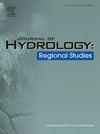Mass loss of Bayi Glacier in the Heihe River Basin revealed by ground-penetration radar measurements from 2006 to 2023
IF 4.7
2区 地球科学
Q1 WATER RESOURCES
引用次数: 0
Abstract
Study region
Bayi Glacier in the Heihe River Basin, northeast Tibetan Plateau.
Study focus
Glacier volume and mass balance are crucial to water supplies and human life within the basin in arid areas. This study employs aerial remote sensing and ground-penetrating radar (GPR) to conduct a comprehensive surveying on Bayi Glacier, mapping its surface and subglacial topography. Furthermore, multi-source remote sensing datasets are used to quantify the changes in glacier area and thickness from 2006 to 2023. The study aims to map the ice thickness distribution, surface and subglacial topography of Bayi Glacier, investigate the changes in glacier mass, volume, and area over the past 17 years, and analyze the influence of climate factors on the spatiotemporal changes of the glacier.
New hydrological insights for the region
Bayi Glacier is a low-altitude glacier, small in area but high sensitivity to climate change, with a volume of 0.1065 km3 and an area of 2.3569 km2. From 2006–2023, the glacier area underwent sustained retreat, decreasing by 0.3266 km2 (12.17 %). The GPR measurements collected in 2006 and 2023 revealed that the glacier thickness and volume decreased by an average of 9.04 m (16.68 %) and 0.0465 km3 (30.39 %), respectively. Rising summer temperatures led to a decrease in solid precipitation and an increase in evapotranspiration, which accelerated the ablation of Bayi Glacier. Additionally, the gentle slope of Bayi Glacier increases its exposure to solar radiation, resulting in a more negative glacier mass balance of −0.532 ± 0.0094 m/year, compared to that of the Qilian Mountains’ glaciers ( −0.366 ± 0.3417 m/year).
求助全文
约1分钟内获得全文
求助全文
来源期刊

Journal of Hydrology-Regional Studies
Earth and Planetary Sciences-Earth and Planetary Sciences (miscellaneous)
CiteScore
6.70
自引率
8.50%
发文量
284
审稿时长
60 days
期刊介绍:
Journal of Hydrology: Regional Studies publishes original research papers enhancing the science of hydrology and aiming at region-specific problems, past and future conditions, analysis, review and solutions. The journal particularly welcomes research papers that deliver new insights into region-specific hydrological processes and responses to changing conditions, as well as contributions that incorporate interdisciplinarity and translational science.
 求助内容:
求助内容: 应助结果提醒方式:
应助结果提醒方式:


